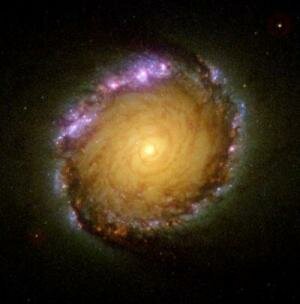Largest Atlas of Nuclear Galactic Rings Unveiled
An international team of astrophysicists has just unveiled the most complete atlas of nuclear rings, enormous star-forming ring-shaped regions that circle certain galactic nuclei.
"AINUR (the Atlas of Images of Nuclear Rings) is the most complete atlas of nuclear rings created to date," says Sébastien Comerón, a researcher at the Institute of Astrophysics of the Canary Islands (IAC), and co-author of the joint study with other scientists from the universities of La Laguna, Oulu (Finland) and Alabama (United States).
The atlas has just been published in the journal Monthly Notices of the Royal Astronomical Society, and covers 113 nuclear rings in 107 different galaxies. Six are dust rings in elliptical galaxies, while the rest (the majority) are star-forming rings in disc galaxies.
The nuclear rings are ring-shaped, star-forming configurations located around galactic nuclei. They range in size on average from between 500 to 3,000 light years, and they are very bright because they contain an abundance of young stars, including some extremely massive ones. This kind of star has a short lifetime but shines very brightly before exploding as a supernova.
To find the rings, the astrophysicists used images from around 500 galaxies observed by the Hubble space telescope, which belongs to NASA and the European Space Agency, as well as using other references. The images were processed using filters, generating various kinds of maps to help identify the rings more easily.
Rings and Lindblad resonances
"The AINUR atlas has also looked for relationships between the properties of the nuclear rings and those of the galaxies in which they are found," says Comerón, "and we have been able to statistically prove that most rings are associated with Lindblad resonances (gravitational shoves that push objects out of certain orbits and into others)."
The astrophysicists have shown that when the rings are in a barred galaxy (within disc galaxies, which have a central cylinder or 'cigar' of stars), the maximum radius that a nuclear ring can attain is 25% of the length of the bar, and that the maximum radius is inversely proportional to the strength of the bar.
This is the behaviour that was predicted for the internal Lindblad resonances, which are determined by the size of the bar and their strength (how elliptical this is). If the bar is small or very elliptical, the resonance orbit becomes small, but if it is large or not very elliptical, the orbits become bigger.

"The largest atlas of nuclear galactic rings has been unveiled. (Credit: NASA, ESA, D. Maoz, G. F. Benedict et al.)"
Source: Spanish Foundation for Science and Technology
|